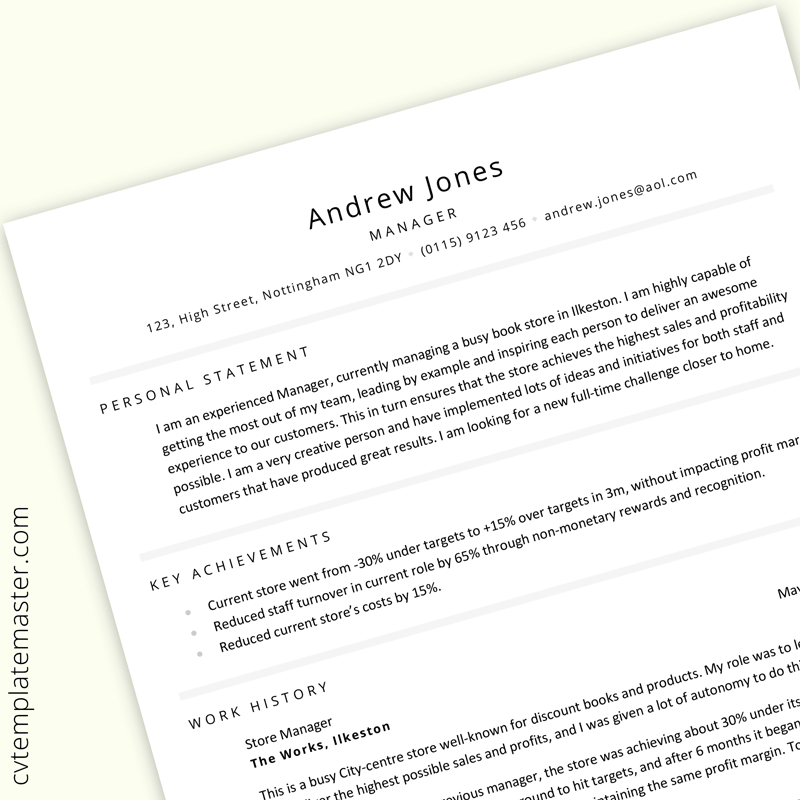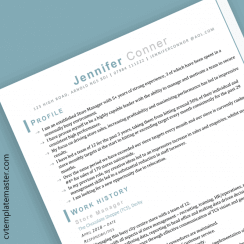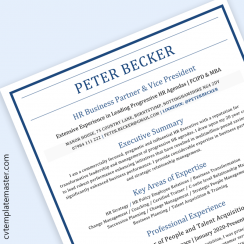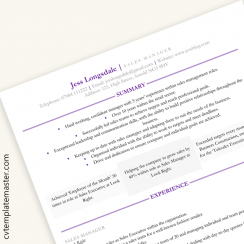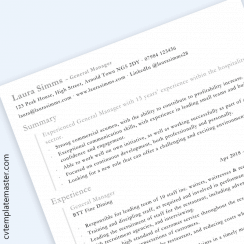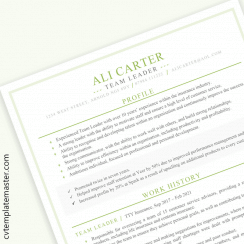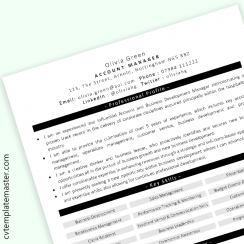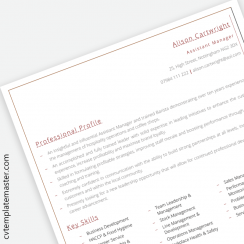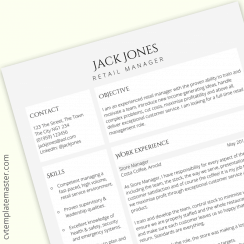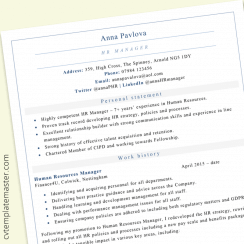Text preview of this CV template:
This is a text-only preview - download the formatted Word file using the link above.
Andrew Jones | MANAGER
123, High Street, Nottingham NG1 2DY | (0115) 9123 456 | andrew.jones@aol.com
PERSONAL STATEMENT
I am an experienced Manager, currently managing a busy book store in Ilkeston. I am highly capable of getting the most out of my team, leading by example and inspiring each person to deliver an awesome experience to our customers. This in turn ensures that the store achieves the highest sales and profitability possible. I am a very creative person and have implemented lots of ideas and initiatives for both staff and customers that have produced great results. I am looking for a new full-time challenge closer to home.
KEY ACHIEVEMENTS
- Current store went from -30% under targets to +15% over targets in 3m, without impacting profit margins.
- Reduced staff turnover in current role by 65% through non-monetary rewards and recognition.
- Reduced current store’s costs by 15%.
WORK HISTORY
Store Manager | May 2014 – date
The Works, Ilkeston
This is a busy City-centre store well-known for discount books and products. My role was to lead the team and deliver the highest possible sales and profits, and I was given a lot of autonomy to do this.
When I took over from the previous manager, the store was achieving about 30% under its sales targets per month. Within 3 months I had turned it around to hit targets, and after 6 months it began consistently exceeding targets by around 15% monthly, whilst maintaining the same profit margin. Today, it continues to exceed targets by between 15 and 30% each month.
The two key changes I made were to introduce non-monetary rewards and recognition for staff delivering awesome customer service, and to completely change the store layout, both to make it more appealing and to maximise the basket spend for each customer. I also did a full costs audit, cutting spend by 15%. In addition, I have completely turned around the previous low morale amongst the team and I now have a happy, motivated team that love coming into work! Consequently staff turnover has reduced by 65%.
Deputy Shop Manager | April 2012 – April 2014
Oxfam, Ilkeston
While looking for a permanent paid position, I volunteered at this busy City-Centre Oxfam store as store manager.
This required me to assist the Shop Manager in leading and develop the team, delegating responsibilities, training and mentoring staff, organising shifts, motivating workers and having a good eye for creating an enticing display on the shop floor. It also required good IT skills for emailing and creating reports; together with a good understanding of successful retail processes and merchandising.
Complaints Manager | May 2009 – March 2012
Bourbon Insurance, Ilkeston
Following a break from work due to a now-resolved health issue, I joined this Insurance Group to lead their customer complaints department. This involved developing a team of 5 complaints handlers and putting in place or refining the existing processes to ensure fair customer outcomes that were in line with regulatory guidance and Financial Ombudsman Service policy.
I was hands-on in my approach, leading my team by example and training them to very high standards.
A key aspect of this role was taking the information gathered from complaints and feeding this back to other departments with recommendations, as part of a process of continuous improvement. The goal of this was to reduce the number of complaints and increase customer satisfaction.
When I started working at the Company, 15% of customers complained on average, with customer satisfaction scores at 3.7/5. By the time I left, just 4% of customers complained on average and customer satisfaction scores had raised to 4.5/5.
Trainee Manager | August 2007 – July 2008
McDonalds, Ilkeston
As a Trainee Manager at McDonalds, I undertook an intensive management training programme, starting with six months learning the business from the ground up. This included hands-on experience across the business including the kitchen, front counter, dining area and drive-thru – working breakfast, daytime, evening and overnight shifts. This helped me to really understand the business needs and challenges, after which I was ready to manage a small team. I progressed through to being responsible for an entire shift and then moved on to take over management of recruitment for the branch.
QUALIFICATIONS
BSc Business Management | September 2004 – June 2007
University of Birmingham
This three year course gave me an excellent foundation in a wide range of business topics, including marketing, economics, human resource management, financial knowledge and skills, operations, law, sustainability, managing and developing people, and labour economics.
A Level Maths (B), English (B) and Business Studies (B) | Completed June 2004
Birmingham College
INTERESTS
In my spare time I enjoy Golf, swimming, road cycling and going to the gym. I have also refereed for the local under 16s Rugby team for the past 5 years which has helped further build my ability to communicate clearly with others, work in a team and pay attention to detail.
Template details:
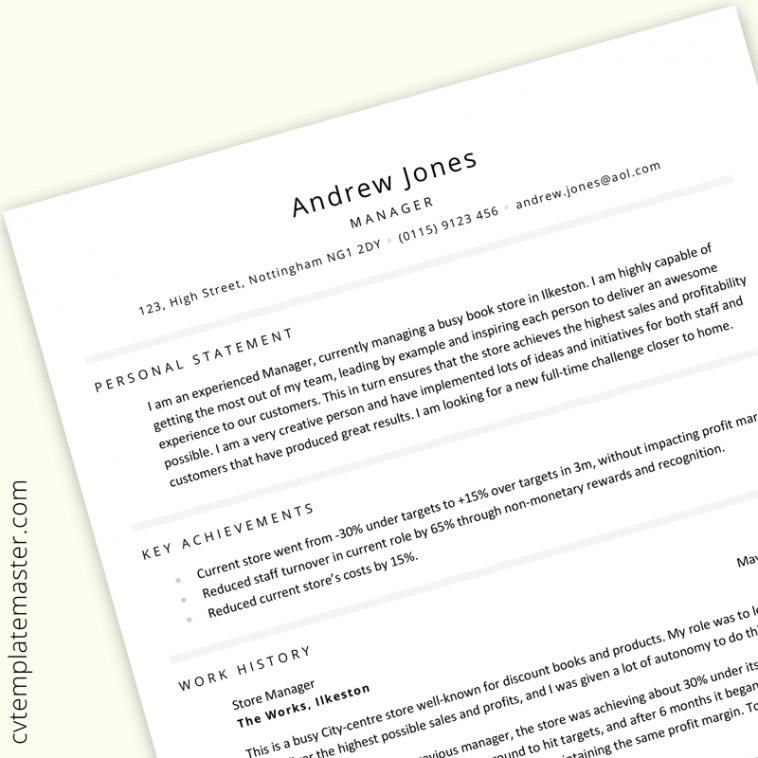
NB: We originally published this UK Manager CV template on 2nd December 2018 and it has now been fully updated for 2020.
Here’s a full preview of page one of this Manager CV:
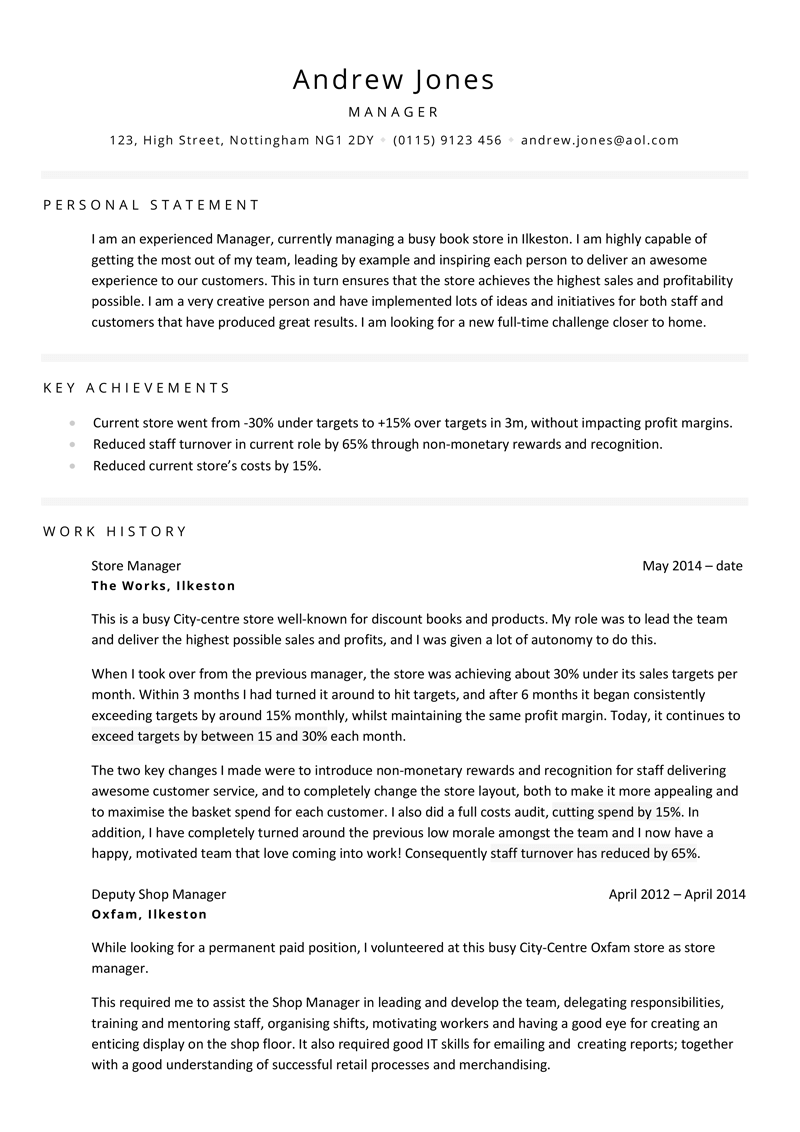
And here’s page two:
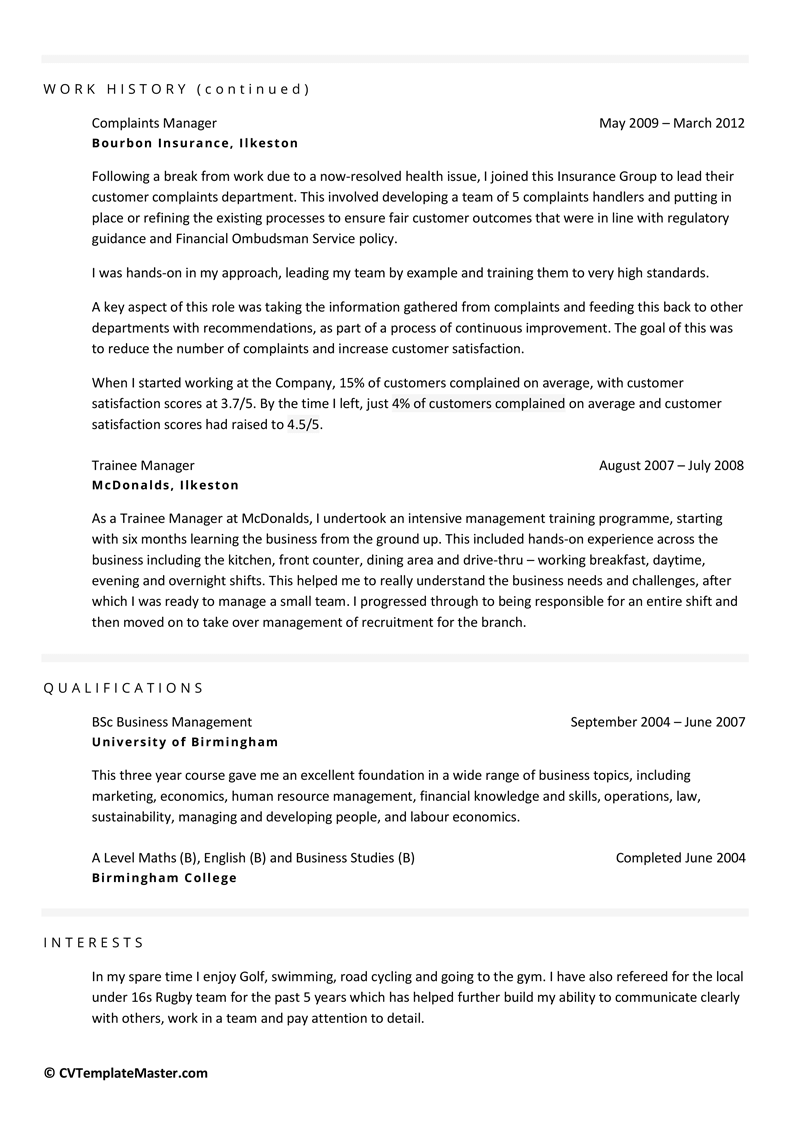
How to write a Manager CV:
Focus your manager CV on achievements
A manager’s contribution to any business should be reflected in the company’s profits, organisation, and overall workplace morale. Therefore, to convince prospective employers that you’re a good manager, you’ll need to show how you’ve impacted your current or past employers’ bottom line. Using the right words on your CV (such as ‘achieved’ or ‘exceeded’) can help guide you towards doing this.
Give evidence of desirable skills
Job adverts for managers always list very similar skills: good communication, leadership, passion and enthusiasm, training/mentoring abilities and so on. However, it’s no good simply listing these off on your manager CV – you need to SHOW employers that you have them by providing evidence.
For example, you might write:
- “I trained and mentored a team of five – we went on to meet and exceed our team targets every month for the past three years….”
- “Our team of five developers worked on three major projects over the past four years, delivering each on time, to spec and to budget…”
- “My January sales campaign went out to 15,000 cold contacts, generating £1.2 new orders from 3,750 new customers…”
- “My redesigned newsletter had a 56% CTR, generating 500 new leads…”
You can see from the above examples that it’s important to be specific. Rather than simply saying you’re creative, give examples of your ideas and how they’ve been successful. Rather than simply saying you’re good at training, show how your training skills have benefited the Company.
If the job advert isn’t too specific about the type of skills the employer is looking for, try looking at some job profiles for inspiration. For example:
Consider joining a professional management organisation
There are a number of organisations that represent managers – and membership of these can help show an interest in and passion for your industry. These include:
If you join a management association, be sure to include it on your Manager CV.
Use social media to your advantage
It’s hard to find managers with real commercial awareness, who keep up to date with industry developments and become involved in their sector. Even if this IS you, how do you demonstrate it to prospective employers prior to the interview?
One way is to use social media to your advantage, by following industry experts, sharing, commenting, posting your opinions on current matters and generally becoming involved. You can then give details of your social accounts (e.g. LinkedIn, Twitter) on your manager CV so that employers can see this activity.
Employers also value the ability to use social media effectively and engage followers – so by demonstrating this, you’ll be proving you have another desirable skill.
Explain any career breaks
Job applicants can get very nervous about handling career breaks – but the best way to deal with them is to explain them briefly and then move on, without any fuss or drama. Took time out to have a baby? Needed time off because of ill health? These matters are easily explained in a line or two. Remember, it’s better to explain a gap rather than leave it to the employer’s imagination.
Use bold type sparingly
It is absolutely fine to use bold type for your headings and subheadings as well as your name and professional title, but be careful not to overdo it. The use of a bold font is meant to attract the eye and highlight something of importance, which is why headings is always a great way to utilise bold type.
Too much bold type can come across strong and aggressive, so it’s always better to keep this to a minimum. As long as you create a CV with a good layout that presents all of your information in an easy to read format, you shouldn’t have any problems with the hiring manager finding what they are looking for.
TIP: Bold text can be used to highlight important achievements – but so can shading! Highlight the text with your cursor and choose shading from the menu as follows:

You’ll see that we’ve used shading to highlight key figures in our sample Manager CV content.
Only underline links to websites
Don’t be tempted to underline information that you deem to be important, as this could also have the same negative effect as bold type and could put the reader off. The same goes for underlining your headings and subheadings – it just isn’t needed. Bold text, larger text or a soft shaded background is an example of a layout feature that can help you differentiate headings without using underlining.
Only use the underline type for any links you provide to a website. For example, underlining would be fine for a LinkedIn URL or your own websites that you are showcasing because they contain content relevant to the position.
Use standard fonts
The most commonly used fonts for a CV are ‘Times New Roman’ and ‘Arial’. They are considered the easiest to read and both look professional and suitable for an important document like your CV or cover letter. Garamond and Open Sans are also standard popular fonts that we use a lot on our templates – both being easy to read and both offering stylish alternatives to Times New Roman and Arial respectively.
There are other fonts that are acceptable like ‘Calibri’ and ‘Cambria’, but if you have any doubts then you can’t go wrong with the standard ones. What you should of course avoid is using the more creative fonts which are available. Not only can these look a little too much like a secondary school art project but if your CV is going out in Word format, they’ll only be visible to employers if the recipient has the font installed. Always go with something that is mainstream, professional and easy to read – there are plenty of alternative ways to be creative in your CV that won’t negatively impact your chances of an interview.
Don’t use a small font size
For most font faces, you shouldn’t go under size 11, with the most commonly used font size for a CV is 12. This makes for easy reading and also allows you to fit everything you want within the usual two page limit for a CV.
Going for a smaller font size just to fit more on the page is ill advised. The exception to this rule is lists of information and small sections of text – i.e. where the employer does not have to read through paragraphs. In these areas, a 10pt font may be acceptable and will allow you to include more information on your CV template. However, don’t go down to 10pt if you’re using a smaller font like Garamond.
On the other hand, don’t go for a font larger than 12 as it will look unprofessional and will take up valuable space that could be better used for showcasing your talents and experience.
Don’t ever use slang or ‘text speak’
Text speak should stay exactly where it is – to a mobile phone! It doesn’t have a place on a CV or any other official document as it immediately looks unprofessional and will almost guarantee your CV being thrown in the trash. An employer wants to see that a lot of effort has gone into creating your CV, and if you are too lazy to type out a word in full then you are going to reflect badly overall.
You should also only use abbreviations if they are well known and are commonly typed that way – like BMW (it would actually look a little strange if you decided to type out ‘Bayerische Motoren Werke’ and probably would get a few heads scratching!)
You can find more guidance on how to write a manager CV here.
